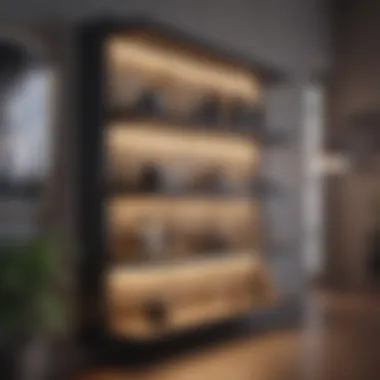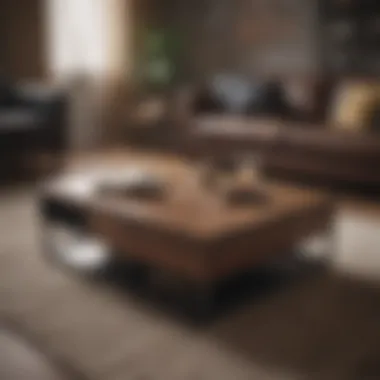Innovative Furniture Layout Ideas for Small Living Rooms - Space Optimization Guide


Outdoor Decor Ideas
When it comes to optimizing a small living room's space, every detail matters. From the strategic placement of furniture pieces to the creative use of vertical space, the goal is to achieve both style and functionality in a compact area. The arrangement of furniture can make a significant difference in how spacious and inviting a room feels. By carefully selecting each piece and considering its placement, a small living room can be transformed into a stylish and practical space that caters to the needs of its inhabitants.
Seasonal Inspirations
With changing seasons come different opportunities to make the most of a small living room. Whether it's cozying up the space during winter with plush throws and soft lighting or opening up the room during summer with light, airy fabrics and minimal decor, seasonal inspirations play a vital role in enhancing the ambiance of a compact living area. By adapting the furniture layout to reflect the season, one can create a versatile and dynamic space that evolves throughout the year.
Furniture Selection
Choosing the right furniture pieces is crucial when designing a small living room layout. Opting for multi-functional furniture, such as a sofa bed or a coffee table with additional storage, can help maximize space without sacrificing style. Selecting pieces that are proportionate to the room's size is essential to prevent overcrowding and maintain a sense of openness. Additionally, focusing on sleek and streamlined designs can create an illusion of more space in a compact living area.
Decorative Lighting
Lighting plays a pivotal role in setting the mood and enhancing the ambiance of a small living room. Using a combination of overhead lights, floor lamps, and accent lighting can help create depth and dimension in the space. Strategic placement of lights to highlight key features or artwork can draw attention to specific areas and add visual interest. By carefully selecting lighting fixtures that complement the furniture layout, one can elevate the overall aesthetic appeal of the room.
Plant Arrangements
Incorporating plants into a small living room not only brings a touch of nature indoors but also helps purify the air and create a sense of tranquility. When arranging plants in a compact space, consider utilizing vertical space by hanging planters or placing tall plants in corners. Opt for low-maintenance plants that thrive indoors and require minimal care to ensure they complement the furniture layout effortlessly.
Hardscaping Solutions
For outdoor living spaces or mini gardens adjacent to small living rooms, hardscaping solutions can play a vital role in defining boundaries and creating visual interest. From custom-built seating areas to integrated planters and pathways, hardscaping elements can enhance the overall aesthetic appeal of the space while providing functional benefits. By seamlessly blending hardscaping features with the furniture layout, one can create a harmonious outdoor area that complements the interior design of the living room.
Sustainable Practices
Integrating sustainable practices into the furniture layout of a small living room not only contributes to environmental conservation but also promotes a healthier indoor environment. Opt for furniture made from eco-friendly materials or upcycled pieces that add a unique touch to the space. Consider refurbishing existing furniture items or repurposing materials to reduce waste and embrace a more sustainable approach to design. By incorporating sustainable practices into the furniture layout, one can create a stylish and eco-conscious living room that reflects a commitment to responsible living.
Introduction
Focusing on the intricacies of furniture layout in small living rooms, this article delves into the art of maximizing space without compromising on style or functionality. Small living areas pose unique challenges that necessitate innovative solutions and a keen eye for design. By strategically placing furniture pieces and utilizing vertical space effectively, individuals can transform their compact living rooms into stylish and practical sanctuaries.


Understanding the Challenge
Analyzing the constraints of small living rooms
When dissecting the limitations of small living rooms, one must acknowledge the spatial restrictions that demand creative solutions. The compact nature of these rooms calls for strategic furniture placement and multifunctional pieces to make every inch count. By understanding the constraints imposed by size, individuals can craft a harmonious living space conducive to both relaxation and entertainment.
Importance of optimizing space without sacrificing aesthetics
Balancing space optimization with aesthetic appeal is a fundamental aspect of small living room design. It's crucial to curate a visually pleasing environment without overcrowding the room, maintaining a sense of openness and airiness. Prioritizing style without compromising on functionality allows for a seamless blend of form and utility, creating a truly refined living experience.
Key Considerations
Functionality
In the realm of small living room design, functionality reigns supreme. Each furniture piece should serve a purpose beyond mere decoration, maximizing usability within limited space. Prioritizing multifunctional items and clever storage solutions can enhance the efficiency of the room, ensuring a seamless living experience that caters to both comfort and practicality.
Visual Appeal
The visual aesthetics of a small living room play a pivotal role in shaping its ambiance. Careful consideration of colors, patterns, and textures can visually expand the space, creating an illusion of openness and sophistication. By integrating harmonious design elements and focal points, one can elevate the room's appeal while maintaining a cohesive and inviting atmosphere.
Traffic Flow
Efficient traffic flow is essential in small living rooms to facilitate ease of movement and functionality. Strategic placement of furniture to optimize walking paths and create designated zones can enhance the flow of the room. By ensuring clear pathways and unobstructed access to key areas, individuals can promote a sense of spaciousness and organization within the compact living space.
Strategic Furniture Placement
Strategic furniture placement holds immense significance in the optimization of small living rooms. In the realm of compact spaces, every square inch matters, necessitating a thoughtful approach to arranging furniture. This section illuminates the pivotal role of strategic furniture placement in maximizing both functionality and aesthetics within limited dimensions. By strategically positioning key pieces, one can create an illusion of spaciousness and ensure seamless movement throughout the room. Vital considerations such as furniture scale, traffic flow, and visual balance will be explored in detail, offering actionable insights for those aiming to curate a harmonious living environment within confined quarters.
Sofa Positioning
When it comes to sofa positioning in small living rooms, the selection of configurations plays a pivotal role in defining the space's layout and functionality. This section delves into two primary sofa positioning strategies: L-Shape Configuration and Floating Sofa.


L-Shape Configuration
Examining the L-Shape Configuration in detail reveals its inherent ability to optimize corner spaces effectively. By utilizing the corner area, this configuration offers a seamless blending of style and practicality, making it a popular choice for compact living rooms. Its unique feature lies in its ability to section off areas within the room without creating visual clutter. While advantageous for defining zones within a space, it is essential to consider its potential limitations in certain room layouts where versatility is key.
Floating Sofa
Conversely, the Floating Sofa approach emphasizes an open-concept feel by positioning the sofa away from walls or corners. This design choice can create an illusion of more space and fosters a sense of airiness within the room. The key characteristic of a floating sofa is its ability to establish a central focal point while promoting a more expansive atmosphere. However, it is crucial to weigh this against potential drawbacks such as limited storage opportunities and the need for an alternative focal point in the absence of a traditional wall-mounted setup.
Multi-Functional Pieces
Integrating multi-functional furniture pieces into a small living room holds transformative potential in maximizing both utility and aesthetic appeal. This segment delves into two versatile additions: Nesting Tables and Sleeper Sofas.
Nesting Tables
Nesting tables offer a dynamic solution for compact spaces, providing flexibility in usage while occupying minimal floor area. Their key benefit lies in the ability to nest within each other, offering scalability in surface area as needed. This characteristic makes them well-suited for entertaining or multifunctional use cases. However, potential disadvantages may include limitations in legroom beneath the tables when nested or reduced individual table size for standalone utility.
Sleeper Sofas
Sleeper sofas represent a seamless marriage of comfort and practicality, ideal for accommodating overnight guests in small living rooms. Their primary advantage is the dual functionality of serving as seating during the day and converting into a bed when required. This versatile piece can be a game-changer for those seeking to optimize space without compromising on guest accommodations. Yet, it is important to note considerations such as mattress quality and ease of transformation, ensuring a seamless experience for both occupants and hosts.
Vertical Space Utilization
Vertical space utilization is a critical aspect in designing furniture layouts for small living rooms. By making use of the vertical dimension of the room, homeowners can maximize space efficiency without compromising on style and functionality. One of the key benefits of vertical space utilization is the ability to create storage and display solutions that are both practical and aesthetically pleasing. When considering vertical space, factors such as ceiling height, wall proportions, and overall room design play a vital role in determining the most effective placement of furniture pieces.
Wall-Mounted Shelving
Wall-mounted shelving is a versatile and popular choice for optimizing vertical space in small living rooms. Display and Storage Solutions integrated into wall-mounted shelves offer a practical way to exhibit decorative items while providing additional storage space. The key characteristic of wall-mounted shelving lies in its ability to free up floor space, creating a more open and airy environment. This feature makes it a preferred choice for small living rooms where space is limited. Moreover, wall-mounted shelving adds a modern touch to the room, enhancing its overall appeal. While the advantages include maximizing space efficiency and adding visual interest to the walls, a potential disadvantage is the need for proper installation to ensure stability and safety in a small space.
Utilizing Tall Bookcases
Emphasizing Height for Vertical Expansion, tall bookcases are an effective way to capitalize on vertical space in a small living room. Their tall and slender design allows them to reach heights that draw the eye upward, emphasizing the vertical dimension of the room. The key characteristic of tall bookcases is their ability to offer ample storage space without expanding into the horizontal plane, making them a popular choice for small living rooms. By utilizing tall bookcases, homeowners can store books, display decor items, and create a focal point that adds sophistication to the room. However, it is essential to consider the balance between the height of the bookcases and other furniture pieces to maintain visual equilibrium in the limited space of a small living room.


Innovative Design Tips
Optical Illusions
Mirrors for Perception of Space
In the intricate tapestry of small living room design, Mirrors for Perception of Space emerge as a pivotal element that can redefine spatial dynamics and create an illusion of expansiveness despite spatial constraints. The strategic placement of mirrors strategically influences the perceived depth and openness of a room, making it an instrumental tool for visually expanding restricted areas. The reflective properties of mirrors bounce light across the room, illuminating corners and creating a sense of airiness. This deliberate play with reflections can ingeniously transform a confined space into a seemingly larger and brighter environment, offering residents a visual respite from spatial limitations. While mirrors excel in maximizing the perception of space, it is essential to note that their placement should be deliberate to avoid overwhelming the room with a cluttered reflection, which could detract from the desired effect.
Strategic Lighting
When contemplating the impact of Strategic Lighting on the ambiance and functionality of a small living room, one unravels the transformative power light wields in molding spatial perception and enhancing design cohesion. Strategically positioned lighting fixtures not only illuminate key areas but also contribute to the overall mood and atmosphere of the room. By strategically placing light sources such as overhead fixtures, floor lamps, or wall sconces, one can manipulate the visual hierarchy within the space, drawing attention to specific design elements while also fostering a warm and inviting ambiance. The interplay between light and shadow adds depth and dimension to the room, accentuating textures and colors. However, it is crucial to strike a balance between sufficient illumination and avoiding excessive brightness that may overstimulate or create glare, disrupting the harmonious visual flow within the space.
Color and Texture
Monochromatic Palette
Within the realm of Color and Texture, the Monochromatic Palette emerges as a sophisticated yet versatile choice that seamlessly integrates into the narrative of space optimization and design cohesion in small living rooms. The utilization of varying shades of a single color evokes a sense of unity and fluidity, creating a visually cohesive environment that appears larger and more harmonious. A monochromatic color scheme also simplifies the visual complexity of a room, minimizing visual clutter and promoting a sense of tranquility. Moreover, a monochromatic palette allows for seamless integration of different textures and materials, adding layers of visual interest without overwhelming the limited space.
Textured Fabrics for Depth
When exploring Textured Fabrics for Depth, one encounters a fundamental strategy for introducing tactile richness and visual depth into small living room decor. The inclusion of textured fabrics such as plush velvet, cozy knits, or sleek leather not only adds a sensory dimension to the room but also infuses a sense of luxury and comfort. Textured fabrics play a crucial role in breaking visual monotony, creating focal points, and imbuing the space with personality. Furthermore, the interplay of different textures adds complexity and sophistication to the design scheme, enticing both the eyes and the touch. However, it is imperative to exercise restraint in texture selection to prevent the space from feeling overwhelming or visually cluttered, striking a harmonious balance between comfort and aesthetics.
Conclusion
In the tumultuous realm of small living room design, the zenith lies in achieving a harmonious synthesis between style and functionality. This conclusion encapsulates the essence of the innovative furniture layout solutions articulated in the preceding sections. As the discussion delves into the convoluted intersection of limited space and aesthetic appeal, the art of balancing style with space optimization emerges as a pivotal linchpin. Navigating the nuances of this delicate equilibrium entails meticulous consideration of every furniture piece's placement and functionality. The meticulous juxtaposition of design elements in a compact space necessitates thoughtful curation and creative ingenuity. Embracing this ethos not only amplifies the visual allure of the living area but also ensures seamless functionality and practicality.
Achieving Harmony and Functionality
Balancing Style with Pace Optimization
Maneuvering through the labyrinth of small living room design intricacies, the process of achieving equilibrium between style and space optimization stands as a beacon of sophistication. Balancing style with space optimization involves a judicious blend of aesthetic refinement with spatial awareness, equipping the room with a semblance of grandeur within its confined dimensions. The core tenet lies in maximizing the allure of the space without burdening it with overcrowded elements, skillfully blending aesthetics with utilitarian needs. Strategically arranging furniture pieces to maintain a sense of openness while harnessing every nook and cranny accentuates the room's visual charm. This meticulous dance of functionality and style ensures that every piece serves a dual purpose, epitomizing both elegance and practicality. While challenges may loom in the path of equilibrium, the rewarding essence of a seamlessly harmonious living area beckons those willing to embrace the intricate ballet of style and space optimization. The advantageous nature of this approach manifests in the creation of a space that not only radiates sophistication but also enhances the convenience of daily living, a testament to the prowess of meticulous design considerations.
Personalized Solutions
Tailoring Layouts to Individual Need
Embarking on the voyage of furnishing a small living room, the beacon of personalized solutions shines brightly, offering a bespoke path to design fulfillment. Tailoring layouts to individual needs empowers inhabitants to curate a living space that resonates with their unique lifestyles and preferences, breathing life and character into every corner. The foundational principle revolves around customizing the spatial arrangement to seamlessly intertwine with the occupants' daily routines and aesthetic sensibilities. By embarking on this personalized journey, individuals transcend the realm of conventional design constraints, paving the way for a living area that mirrors their essence. The intrinsic beauty of tailored layouts lies in their ability to infuse a space with personalized flair, transforming it into a sanctuary that exudes individuality and charm. Harnessing the power of tailored design not only confers a sense of ownership and comfort but also elevates the living experience to a realm of unparalleled bespoke luxury. While challenges may arise in the pursuit of tailoring layouts to individual needs, the ultimate reward lies in the creation of a living space that not only captivates the eye but also nourishes the soul, a testament to the transformative potency of personalized design.







